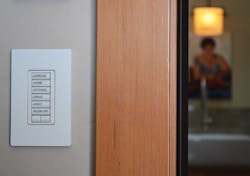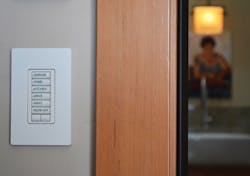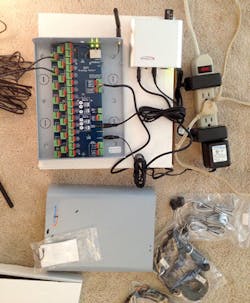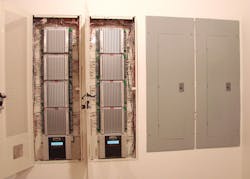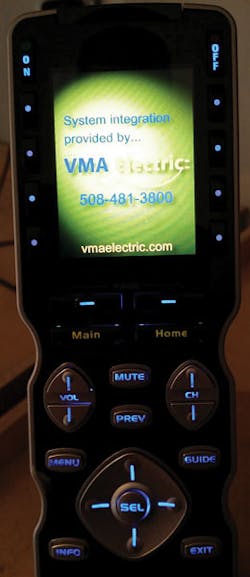Six Strategies to Succeed in the Smart Home Market
Eight years ago, the electricians for VMA Electric were pulling electrical wiring for new homes under construction. Right behind them, low-voltage electrical crews were installing structured wiring for high-end home automation systems. Right then, Victor Archila, owner and president of the Marlborough, Mass.-based electrical contracting company, had an aha moment.
“I asked myself, what separates us from them?” says Archila, a master electrician for the last 15 years. “During the recession, there was still work in the high-end residential market, and these clients were still spending money. I wanted my company to have another option to get into the higher-end market, and home automation fit the bill.”
To break into this market, Archila invested in training for a system that is not only cost effective for the homeowner, but also easy to program. In turn, over the years, he has been able to build up business to the point where home automation projects comprise about 40% of his company’s workload.
VMA Electric is not alone. Other electrical contracting companies nationwide are also breaking into the home automation market, which is expected to grow to a projected $5.5 billion this year, according to BBC Research & Consulting — a Denver-based consultancy firm.
To effectively succeed in this market segment, however, electrical contracting companies must invest in training, build an experienced team, and be familiar with the systems they are installing. Here are six strategies they can consider to follow in the footsteps of today’s home automation experts in the electrical contracting industry.
1. Know the products inside and out.
Before offering to install home automation equipment and systems, some electrical contracting employees are opting to try them out in their own homes. That way, they can identify issues and work out any problems before their electricians come face-to-face with potential clients.
For example, after completing a two-week training session with the manufacturer, Archila installed a promotional installation kit in his own home. This gave him the opportunity to test the programming features and ensure everything communicated properly together and also back to the main source.
“One of the things I wanted to do as an owner and also as an electrician was to know the products myself,” Archila says. “Before I started bringing other people on board, showing them the ropes, and training them, I took all the training to become certified. I am now familiar and up to speed on every system we have installed.”
Kim Adelman, business development manager for home automation at Mark Snyder Electric in Poway, Calif., also installed a new home automation system in his home. A year-and-a-half ago, the software engineer helped the company enter the home automation market. Today, he is working with a team of electricians to program the home automation system for other clientele.
2. Build a great team.
When working on a smart home, electrical contracting companies often have an advantage over other pure integration contractors because they understand the electrical requirements that automation and lighting systems need to work properly, says Kent Felder, owner of Felder Electric, Inc., Lakeville, Minn.
“The wiring for lighting loads with these systems is run a little differently, and greater organization for loads is required for less confusion from start to finish,” Felder says. “Our electrical understanding also helps us to design systems that can be efficiently installed and essentially minimize unneeded additional costs to the customer.”
At the same time, electrical contracting companies must also learn to program the smart home systems. Since they may not have this capability and expertise in-house, they often bring software engineers and low-voltage electricians on board. For example, by employing two installers for A/V automation, a full-time programmer, and 16 electricians, Archila says his company can easily work with homeowners when they want to make a change on their systems.
“We always have someone available,” Archila says. “The worst thing you can do is install the system and not give them the support they need afterward.”
While it can be challenging to put the right team together under one roof, it is worth the time and effort, says Pete Sepesi, project manager for American Electrical Contracting in Jacksonville, Fla.
“On your staff, you need someone who is savvy with programming and comfortable with computers,” Sepesi says. “In addition, you need electricians who can wire multiple switches to control one load. That way, if something is not working, you have the expertise on your team to solve the problem. This approach works out much better than if you had to work with a separate contractor.”
For the last year, Sepesi has worked with a dedicated electrical crew on the smart home projects. After the electrical team installs all of the smart devices, Sepesi performs the advanced programming. If the crew is working on a smaller job, he teaches the electricians to do the basic to intermediate programming. If the contractor is working on a large-scale project (with a significant number of devices), then the crews split up the work.
BR Electric Service, an electrical contracting company in Blue Ridge, Ga., took a similar approach by hiring a low-voltage security expert to work with its six electricians. Because the electricians are cross-trained, they can lend a helping hand at any time.
“This helps keep the quality of work high because we know what we are capable of,” says owner Rodney Kendall. “When you outsource to other people, sometimes you get something that is not up to par.”
By having both low-voltage technicians and electricians on staff, however, electrical contracting companies can circumvent this challenge. For example, Huston Electric in Kokomo, Ind., created a technology division and hired Nate Cushman, a custom electronics integrator and telecommunications journeyman.
“I work with highly trained electricians from the union hall or from our service group to work on retrofit or new construction projects,” Cushman says. “So far, it has been a good thing and has made a lot of sense.”
3. Focus on client convenience.
Electrical contracting companies are not only focusing on creating diverse teams, but also on offering the latest technology to their home automation-seeking customers. For example, homeowners used to exclusively control their systems with a wall control panel, but five years ago, they began using their mobile devices to control functions within their home.
“Everyone is now walking around with a device in their pocket that they can use to work, play, and take over the world,” Sepesi says. “Now they want to use these devices to make life a little easier at home. Their smartphones now provide a view into their home automation systems.”
In his experience, Felder says his customers want to be able to not only control lighting and automation with these mobile devices inside their homes, but also from anywhere in the world. In turn, manufacturers have developed mobile apps that allow homeowners to turn on or off indoor or outdoor lights, lock or unlock doors, or control temperature settings — even while they are away from home.
Additionally, these once-independent systems are now being seamlessly integrated. Felder says it has now gotten to the point that if something in a home or business is electronic, it can be connected to automation and lighting systems. Today, these systems can control lighting as well as audio components, security cameras, thermostats, window blinds, and even security systems.
“Integration is one way these systems have changed in the last 10 to 15 years,” Felder says. “They have also become more reliable, efficient, and much more capable.”
While the systems can get as complex or as complicated as an installer or programmer wants to make them for the customer, Felder Electric strives to make them easy to operate and control.
“Really, the sky is the limit, and it seems like if someone can think it, these systems can do it,” Felder says. “We pride ourselves in designing our systems so that the customer doesn’t need to go through a training session like we did in order to use it effectively and effortlessly. Because that is what these systems really are about — making life easier and more convenient.”
4. Use efficiency as a selling point.
When investing in smart home technology, homeowners are not only looking for convenience, but also energy conservation. For example, Mark Snyder Electric, which also installs photovoltaic and solar water heating systems, helps clients tie their renewable energy systems into their home automation devices.
To conserve water, the irrigation system can be tied into a weather reporting system, which can calculate the amount of water needed to run the sprinklers. In addition, the smart devices can interface with solar hot water systems to heat a spa to a certain temperature before a homeowner even arrives home, Adelman says.
By automating lighting controls, homeowners can also save a significant amount of energy. Sepesi says his company’s clients are automating everything from kitchen lights to garage lanterns to save on their energy bills.
“While everyone is moving to LED lamps, which drop energy use from 60W per lamp to 6W per lamp, they still might be leaving the closet lights on and not even realize it,” he says. “Helping customers understand the full potential of a system is a big factor in the cost savings.”
Today, home automation system manufacturers are partnering with diverse companies to integrate their products into their audio, security, or heating and cooling systems and include them in their user interfaces. For example, from a remote location, homeowners can modify the temperature settings within their home. Rather than running their air conditioning at full blast, they can knock down the temperature by a few degrees and trim down their electric bill.
“By integrating the thermostat with their security system, they can tap an icon on their smartphone when they are away from home to arm the security system, lower the temperature on their A/C system, and dim the lights,” Archila says. “Then, about 10 minutes before they arrive back home, they can simply hit the ‘arrive home’ button on their phone, and it turns on the lights, adjusts the thermostat, and disarms the security system.”
While energy savings is very important to homeowners in their primary residences, it is even more critical when it comes to “second” or vacation homes, Kendall says. Over the last three years, BR Electric Service has provided automation services for new homes in the Blue Ridge Mountains. By installing generators that are connected to the smart home system, the electricians can set the equipment to run on manual cycles rather than running constantly while the owners are not home.
“This market has grown by leaps and bounds,” Kendall says. “We work in a mountainous area, and in the last year, a large influx of people want the automated systems. That way, they can watch their second home from their primary home, shut things down, and keep an eye on the place.”
5. Learn how to install hard-wired and wireless systems.
In order to allow homeowners to take full advantage of the automation services and products available today, electrical contracting companies must be prepared to install systems in both new and existing homes.
When working on new construction, VMA Electric first brings in an electrical team to install the electrical wiring and then a second crew to handle the structured wiring and home automation equipment. While many of his clients believe in the value of structured wiring, Archila says his team has also retrofitted existing homes with wireless systems. When possible, however, Sepesi says it is always a good idea to install a blend of wired and wireless devices or go completely with structured wiring.
“With wireless, there is always the chance of an interruption,” Sepesi says. “If something is not hard wired, it can be susceptible to telephone and radio interference. Hard wiring eliminates that possibility, and gives you more reliable results.”
The wireless systems, however, have made it easier for homeowners to retrofit their existing homes to accommodate smart devices, especially when it’s not feasible to run wires due to time or budget reasons, Sepesi says.
“In the old days, you had to bring in an electrician to cut holes in walls and run wires,” Sepesi says. “Now you don’t have to do any damage to your house. We can set up smart devices without a customer having to worry about painting and patching walls afterward.”
6. Leverage the DIY trend.
The Smart home devices have not only become wireless, but they have also dropped in cost. When they first hit the scene, they were considered a luxury item for well-to-do homeowners. Today, anyone can go to a local hardware or home improvement store to buy consumer-friendly devices priced at under $100 each, and then set up a central hub in their homes.
“Five years ago, smart technology may have seemed out-of-reach for the average family, but now these devices are affordable and can be retrofitted,” Sepesi says. “Rather than running wires everywhere, homeowners can go out and pick out an item. When they hook it up themselves, they get excited, which makes them want to grow their system.”
After installing the first device on their own, they often turn to electrical contracting companies to help support a larger-scale smart-home system, Sepesi says.
“I think it gets people thinking about lighting control, and that is a big part of the electrical market,” Sepesi says.
Looking ahead, Adelman believes the smart home market could follow the same path as personal computers. When PCs were first commercially available, they were only in a few select homes, but today, nearly every house has at least one desktop or laptop computer.
“I see it coming,” Adelman says. “I don’t know the exact direction or how fast, but I have a feeling that it will be the next big thing.”
Cushman agrees, saying that as time goes on, smart home technology will be a normal feature in most new homes, especially as the prices keep sliding down.
“It’s like the central air conditioning in the 1950s,” Cushman says. “Back then, only the wealthy could afford it, and now we all take it for granted. I think home automation will be like that in the next 10 to 20 years. The question is what platform will prevail?”
Fischbach is a freelance writer and editor based in Overland Park, Kan. She can be reached at [email protected].
SIDEBAR: Three Tips for Selling Home Automation Services
Tip No. 1 — Showcase your products. Homeowners may have a difficult time visualizing the benefits of home automation systems. To more effectively sell its products and services, Felder Electric recently installed a showroom (shown above) that it plans to use for future customers. “The tough part about selling home automation is the best way for people to understand it and fall in love with it is for them to see it happen right before their eyes,” says Kent Felder, owner of Felder Electric.
Tip No. 2 — Keep up on the latest technology. Smart devices and systems are rapidly changing, and to stay up to speed, electrical contracting companies must keep a close eye on the latest trends and technology, says Nate Cushman, custom electronics integrator and telecommunications journeyman for Huston Electric. “There are so many changes in this market,” Cushman says. “You must do your personal research by checking out tech forums, reading magazines, attending training, and turning to resources like the Custom Electronic Design and Installation Association (CEDIA).”
Tip No. 3 — Get properly trained. While more and more electrical contracting companies are breaking into the market, not all of them have received the proper training, says Victor Archila, owner and president of VMA Electric. “Some guys think they can do it all and figure it out as they go,” he says. “If they are going to get into automation, they must know the system they are selling and be properly trained in that system, or they won’t be able to do it properly for their clients.”
